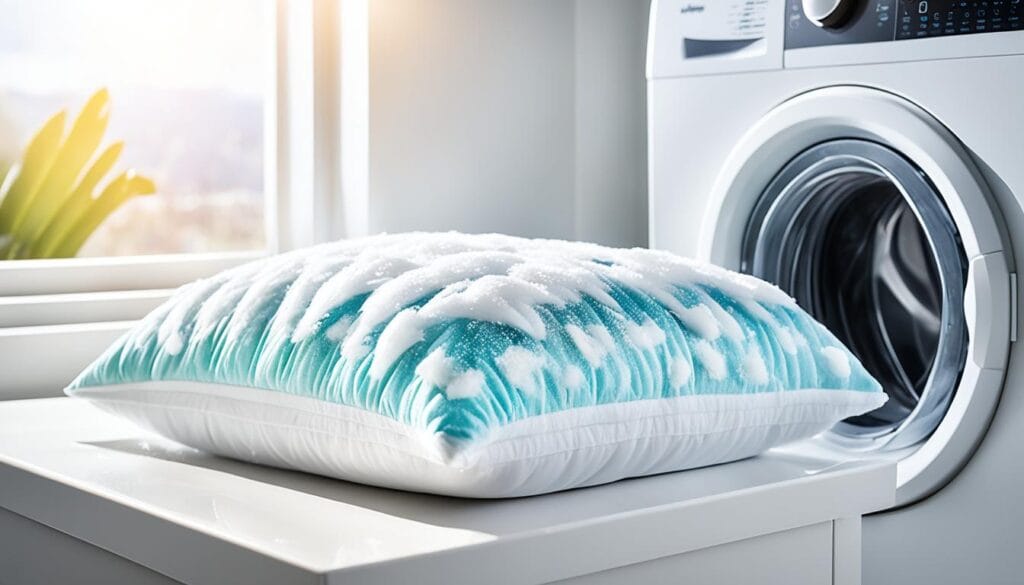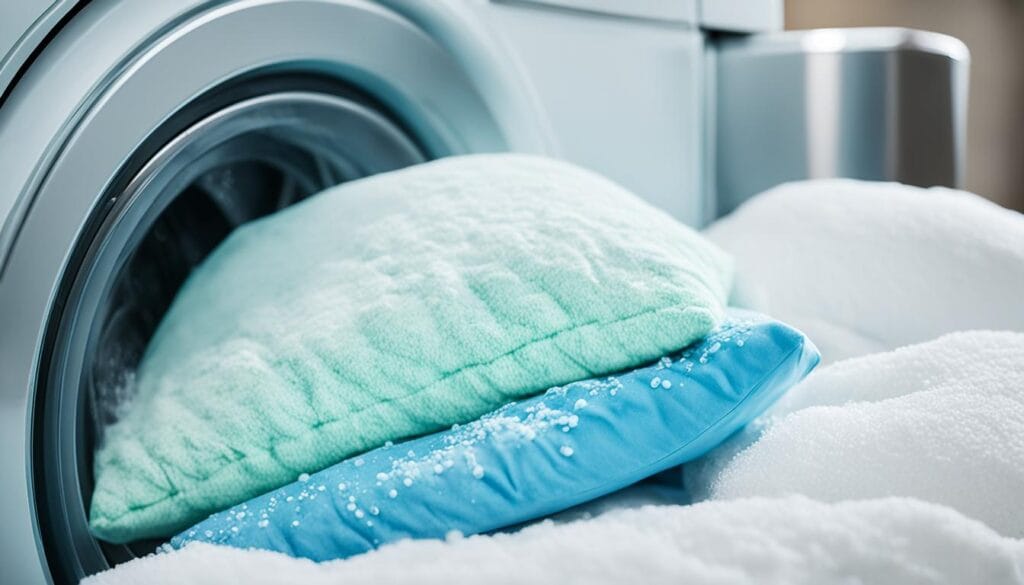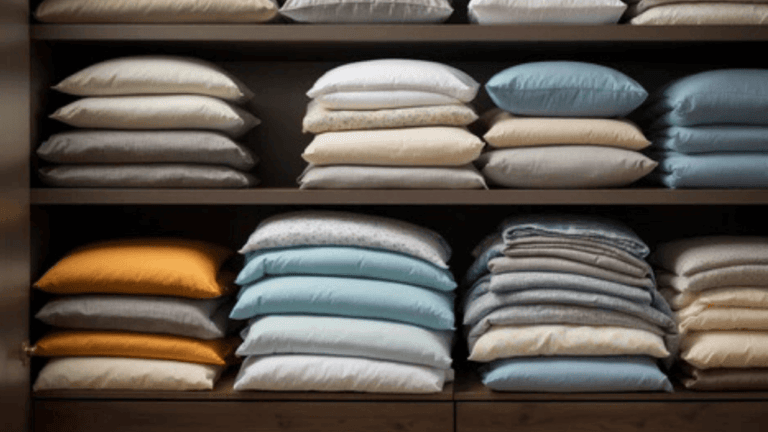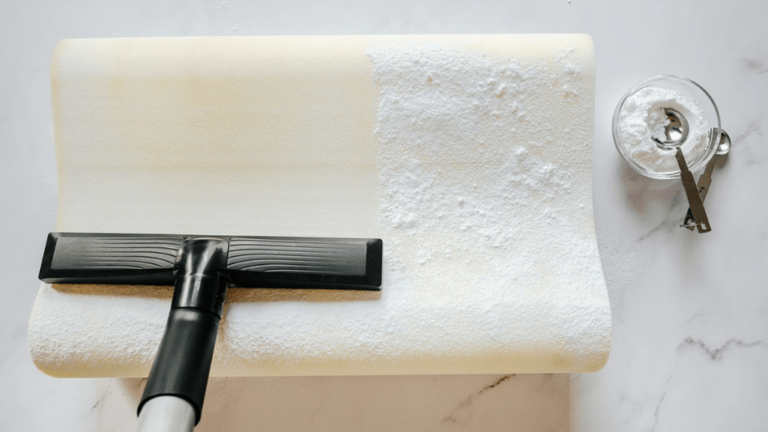Feather pillows are known for the comfort and support they provide. Must know how to wash a feather pillow to keep them in good shape. The Down & Feather Company suggests not washing them often. Instead, they recommend using pillow protectors. This guarding method helps keep the pillows clean without washing away their natural oils. Washing too frequently can harm the feathers, making them less effective in wicking moisture. Plus, it could cause mold or mildew issues.
Key Takeaways
- Feather pillows should be washed only when necessary to preserve natural oils.
- Use pillow protectors to reduce the need for frequent washing.
- Follow specific washing and drying instructions meticulously to prevent damage.
- Always use low-sudsing detergent and select the delicate cycle when washing.
- Ensure pillows are thoroughly dried to avoid mold and mildew.
Understanding Feather Pillow Care
Feather pillows are filled with natural materials that have protective oils inside. These oils keep the feathers soft and strong. But, washing them too often can remove these oils. This makes the feathers dry and more likely to break.
To keep your feather pillows in great shape, wash them only when necessary. Most pillows get yellow over time from sweat and oils. Without excess washing, a feather pillow can last seven to ten years.
You can also protect your pillows with special covers and cases. Regular fluffing will help keep their shape and support. It’s best to wash feather pillows every six months, unless there’s an emergency. Remember, avoiding strong detergents will help keep the natural oils in the feathers.
Why Should You Avoid Washing Feather Pillows Frequently?
Knowing how to care for your feather pillows helps them last longer. They have natural oils that keep them in good shape. These oils also help the feathers stay durable.
Protective Oils in Feathers
Washing feather pillows often removes these oils. Without the oils, feathers get weak and can break. It’s best to only wash them when you really have to. This way, your pillows can stay fluffy for five to ten years.
Risks of Moisture and Mold
Drying feather pillows well is very important. If not dried completely, they can attract mold. It’s advised to dry pillows completely. This might mean drying them more than once.
Stopping the dryer to fluff the pillows every 15 minutes is recommended. This ensures they dry evenly. It also prevents mold.
Using pillow protectors and cases can help. They guard against body oils and keep the pillows dry. Fluffing the pillows regularly by hand also maintains their comfort.
Choosing the Right Time to Wash Your Feather Pillow
Washing a feather pillow at the right time keeps it in great shape. Knowing when it needs a wash is key. Recognizing the signs helps you choose the right time. This keeps your pillow’s quality and life span strong.
Identifying Emergencies
Feather pillows should be washed as a last resort. For example, if a pet, especially a cat, urinates on it. Urine contains ammonia that can harm the feathers. Immediate washing prevents bad smells and bacteria growth.
Signs Your Pillow Needs Washing
Your pillow might need washing if you see yellowing stains. These stains come from body oils and sweat. Washing is also needed if bad smells stick around, even after airing it out well.
Taking care of your feather pillow is crucial. Don’t overdo it with detergent, as this can harm your pillow. Using gentler products like My Green Fills is better. Feathers need to dry properly to avoid mold, which might mean a few drying cycles.
Using pillow protectors and fluffing your pillow helps a lot. Protectors guard against oils and moisture. Fluffing your pillow keeps it comfortable. Use these tips to keep your pillow lasting longer and stay comfy.
| Indicators | Action Required |
|---|---|
| Pet Urine | Immediate washing |
| Yellowing from Body Oils | Consider washing |
| Lingering Odors | Consider washing |
| Dirt and Dust | Spot cleaning |
| General Maintenance | Use pillow protectors |
For detailed advice on washing feather pillows, check out Down & Feather Company’s expert tips. They advise washing rarely and with care.
Step-by-Step Guide on How to Wash a Feather Pillow
It’s important to clean your feather pillow smartly. This way, you make it last longer. You also keep its comfort and support high. Follow this easy guide to clean your pillow right.
Preparation
First, take off any pillowcases or protectors. Look for tears and fix them so feathers don’t escape. Always wash two pillows together. This keeps your washer balanced during spinning.
Washing Process
Wash your pillow in a front-loading machine on a gentle cycle. Use cold water to protect the feathers. Don’t use regular detergent because it can harm the feathers. Use a mild soap without any extra stuff added.
Experts say you should wash feather pillows every six months. But, sometimes you might need to clean them more often.
Drying the Pillow
Drying a feather pillow well is very important. It keeps mold and mildew away. Dry it on low heat but for a good while. You might need to dry it more than once to fully dry it.
Putting tennis balls or wool dryer balls in the dryer with the pillow helps. They stop the feathers from clumping together. This makes sure all the feathers dry evenly.
Keep fluffing the pillow as it dries. Make sure it’s completely dry before using it. If the pillow is still moist, it might start to smell musty.
| Action | Recommendations |
|---|---|
| Load Balance | Wash two pillows at a time |
| Water Temperature | Cold water |
| Drying Aid | Tennis balls, wool dryer balls, or clean canvas shoes |
| Frequency | Every six months, potentially every three months for some cases |
Use this guide to wash your feather pillow with ease. It will help you keep your pillow in great shape for a long time.
Common Mistakes to Avoid When Washing Feather Pillows
Proper pillow hygiene is key to getting good sleep. Clean pillows make resting even better. Yet, cleaning feather pillows the right way can be hard. Let’s look at what not to do:
- Using detergent: Normal detergents can harm feather pillows. They remove natural oils and affect comfort. Use a special detergent for feathers.
- Inadequate drying: The worst mistake is not fully drying feather pillows. This can lead to mold. Dry them completely on low heat.
- Overloading the washing machine: Too many pillows in the wash means they won’t clean well. Add towels to balance the load for better cleaning.
- High heat: High heat can ruin feathers. Always use a gentle cycle and low heat to wash and dry pillows.
To keep your feather pillows in top condition for longer, follow these cleaning tips:
| Mistake | Solution |
|---|---|
| Using detergent | Use a gentle detergent made for feathers |
| Inadequate drying | Run multiple drying cycles on low heat |
| Overloading the washing machine | Balance the load with towels |
| High heat | Use low heat settings |
By sticking to these tips, you avoid the most common pillow washing mistakes. This means your pillows stay clean and cozy. And that’s a big part of enjoying a great night’s sleep.
Alternative Cleaning Methods for Feather Pillows
Keeping feather pillows in good shape is key for them to last long. Instead of washing them often, we should look into other ways to keep them clean. These methods help keep feathers intact and the pillow fresh without needing a lot of washing.
Using Pillow Protectors
Using pillow protectors is the first step in the best way to clean a pillow. They guard against body oils, moisture, and other dirt, stopping them from getting into the pillow. This can make your pillow last for up to 10 years. Protectors also mean you don’t have to wash your pillow as much, saving its natural oils.
Buying a pillow protector is a smart move for feather pillow care. It may make the pillow a bit less soft, but the good points are more. Plus, trying a protector is a low-cost way to see if it fits your needs. This makes it good for keeping your pillow clean without a lot of trouble.
Spot Cleaning Techniques
Spot cleaning is great for small messes on feather pillows. For a stain or spill in one area, a bit of mild soap and a damp cloth can be enough. Just be gentle when you clean, and don’t wet the whole pillow. Spot cleaning keeps the pillow fluffy and in good shape.
For a gentler, best way to clean a pillow, try spot cleaning. It uses less water and keeps the feathers in good condition. By using these methods, your feather pillow can stay fresh and clean with less washing.
- Use pillow protectors to reduce washing frequency and extend pillow life.
- Employ spot cleaning techniques for localized stains to preserve pillow integrity.
Maintaining Your Feather Pillow for Longevity
Looking after your feather pillow is crucial to make it last longer. Using a few pillow care tips regularly can keep it in top shape for years.
Regular Fluffing
Fluffing your pillow often is key. It keeps the pillow soft and the feathers even. Do this by hand a few times each week. It not only removes dust but also helps you sleep better by supporting your neck.
Avoiding Excessive Compression
Don’t flatten your pillow by folding or squeezing it too much. This can harm the feathers inside, making the pillow less comfy over time. Using a pillow protector is smart. It keeps oils and sweat away, protecting your pillow. Plus, always use it and store it right to maintain its softness and support for a long time.
Signs It’s Time to Replace Your Feather Pillow
It’s vital to notice when your feather pillow needs replacing. If you wake up with neck pain, your pillow might be too old. Aged pillows often lose their ability to support your neck properly.
If your pillow has visible damage, like feathers sticking out, it’s time to change it. Feathers wear out over time, especially with poor care. Also, if your pillow smells bad after washing, replacing it is a good idea for hygiene and comfort.
A feather pillow that’s getting old may not be as comfortable as it once was. Even though a good feather pillow can last 7-10 years, ongoing support is essential. Without it, it’s time to get a new pillow for better sleep and health.
The following table highlights the primary pillow replacement signs:
| Replacement Sign | Description |
|---|---|
| Consistent Neck Pain | Persistent discomfort upon waking indicates loss of support. |
| Visible Wear and Tear | Feathers breaking down, quills poking through the fabric. |
| Persistent Odors | Unremovable smells, even after proper cleaning. |
| Decreased Support | Pillow no longer maintains shape and provides adequate cushioning. |
If you spot any of these signs with your pillow, consider buying a new one. This decision is crucial for both comfort and health benefits.
Conclusion
It’s crucial to care for and clean feather pillows properly. Knowing *how to wash a feather pillow* helps it last longer and stay comfy. You should wash your feather pillow about once a year, or every six months for better freshness. Use mild detergents, and stay away from harsh chemicals like bleach to keep the feathers safe.
Feather pillows have been prized for centuries for their softness and were once a sign of wealth. They can last 7-10 years, but it’s important to know when they need to be replaced. Using pillowcases and protectors helps a lot. It makes them last longer by protecting them from getting dirty and keeping the feathers in good condition.
But, keeping a pillow clean doesn’t just mean washing it. Spot-clean when needed and make sure to completely dry it. You can use low heat in the dryer and even tennis balls to keep its shape. *Maintaining and washing feather pillows* well means balancing gentle cleaning with smart protection. With the right care and regular washing, your feather pillow will keep you comfortable and cozy for sleep.










